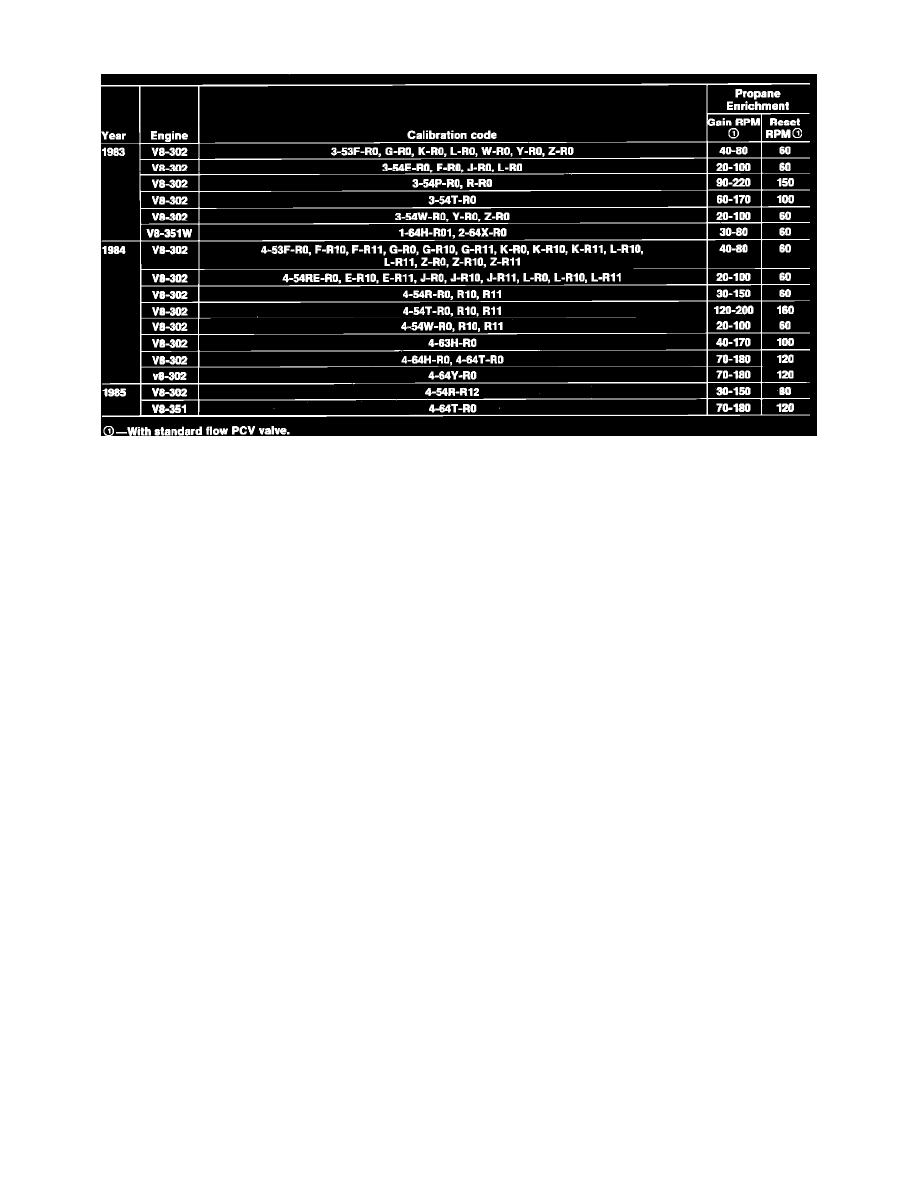F 100 2WD Pickup V8-302 5.0L (1983)

Air/Fuel Mixture: Adjustments
Fig. 1 Propane enrichment specifications
Refer to Propane Enrichment Chart, Fig. 1, when adjusting.
1.
Apply parking brake, block wheels, disconnect automatic brake release, if equipped, and plug vacuum connection.
2.
Connect suitable tachometer to engine.
3.
If vehicle is equipped with hot idle compensator (HIC), ensure HIC is in closed position and remains closed throughout test. Idle vehicle on
kickdown step of fast idle cam for three to five minutes to ensure HIC is closed.
4.
On 1983 models except V8-302 engine with 2150A-2V feedback carburetor, proceed as follows:
a. Disconnect fuel evaporative purge return hose, if equipped, and plug connection.
b. Disconnect fuel evaporative purge hose, if equipped, at air cleaner and plug nipple.
5.
On all vehicles, disconnect flexible fresh air tube from air cleaner duct or adapter, then, using tool T75L-9600-A or equivalent, insert tool hose
approximately 3/4 of the way into duct or fresh air tube. Secure hose with tape as necessary.
6.
On vehicles equipped with thermactor systems, revise dump valve vacuum hoses as follows:
a. On dump valves with two vacuum fittings, disconnect and plug hoses.
b. On dump valves with one fitting or combination air bypass/air control valve, except vehicles with feedback carburetor, remove hose at dump
valve and plug hose. Connect slave hose from dump valve vacuum fitting to an intake manifold vacuum fitting.
c. On V8-351 engine equipped with 4180C-4V carburetor, disconnect and plug vacuum hose to dump valve.
7.
On 1984 - 85 models with feedback carburetor, disconnect battery ground cable for at least 10 seconds.
8.
On all models with feedback carburetor, proceed as follows:
a. Disconnect electrical connector at engine coolant temperature sensor.
b. Disconnect and plug hose from manifold absolute pressure (MAP) sensor.
c. Disconnect and plug hose from carburetor vacuum operated throttle modulator (VOTM).
d. Connect vacuum pump to manifold port of MAP sensor, evacuate to at least 20 inches Hg. and hold.
e. Start engine. Leave all vacuum hoses attached to air cleaner assembly when moving assembly to perform carburetor adjustments. The air
cleaner assembly must be in place when measuring engine speeds. Prolonged engine idling may cause catalyst overheating and excessive
underbody temperatures.
9.
On all vehicles, ensure that ignition timing is set to specifications.
10.
Check engine curb idle speed or A/C-OFF RPM, adjusting as necessary. Remove PCV valve from grommet and allow PCV to draw underhood air
during idle fuel mixture check.
11.
With transmission in neutral, run engine at approximately 2500 RPM for 15 seconds for each mixture check.
12.
With engine idling at normal operating temperature, place transmission in specified gear, gradually open propane tool valve and watch for engine
speed gain, if any, on tachometer.
13.
When engine speed reaches a maximum and then begins to drop off, note the amount of speed gain. The propane cartridge must be in vertical
position. If engine speed will not drop off, check propane cartridge gas supply. If necessary, repeat steps 11 through 13 with a new propane
cartridge gas supply.
14.
Compare measured speed gain to specified speed gain.
15.
If measured speed gain is within specifications, proceed to step 20. If carburetor assembly is equipped with a tamper resistant idle adjustment
feature, the carburetor must be removed from the vehicle. If idle fuel mixture adjustment is necessary, adjust mixture according to reset RPM
specification.
16.
If measured speed gain is zero and minimum speed gas specification is zero, proceed to step 19.
17.
If measured speed gain is higher than specification, turn mixture screw(s) counterclockwise in equal amounts while simultaneously repeating steps
